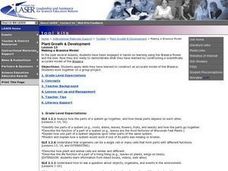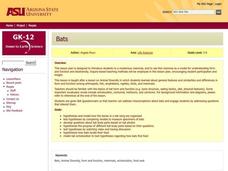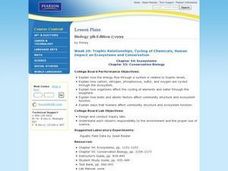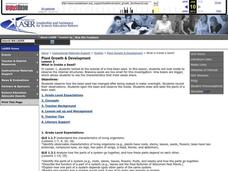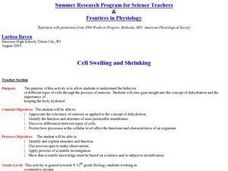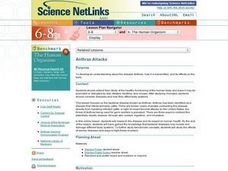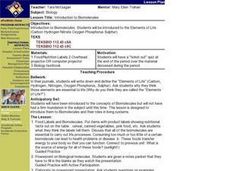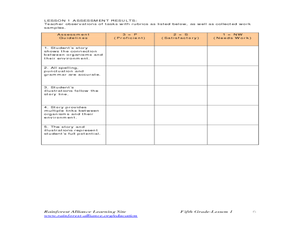Curated OER
Great Depression's Impact on Organized Labor
Students investigate that labor unions recruited more workers to join their ranks during the Depression, and speculate as to why this growth occurred when it did. They research the impact of federal legislation of the New Deal (esp. the...
Curated OER
Organization of Fairfax County Government
Students identify Fairfax County government as council-manager government, describe term of office held by members of Board of Supervisors and districts they represent, how Chairman of Board of Supervisors is elected and term and...
Curated OER
Making a Brassica Model
Young scholars apply skills they have learned to construct an accurate model of the Brassica and then work together on a group project. They analyze how the parts of a system go together, and how these parts depend on each other. ...
Curated OER
My Habitat Address
Sixth graders draw a habitat and write about what they would need to survive in the habitat. They define the input of items such as materials, energy, and information, and what goes out of the habitat. They play a "Habitat Address" game,...
Curated OER
Ecology and the Conservation of Natural Resources
Learners examine the habits of various organism and evaluate the need for conserving natural resources. They role-play as migrating birds traveling between habitats encountering hazards along the way. They observe animals in a...
Curated OER
GMOs: Should We Grow Them?
Students examine the ethics of biotechnology and genetically modifying various organisms. They complete various activities and labs on GMOs and then write a position paper regarding their individual opinions on the subject.
Curated OER
Bats
Students model how the bones in a bat wing are organized. They develop questions about bat body parts based on photographs. They hypothesize how bats locate their food.
Curated OER
Trophic Relationships, Cycling of Chemicals, Human Impact on Ecosystems and Conservation
Students explore how the energy flow through a system is related to trophic levels. They investigate how organisms affect the cycling of elements and water through the biosphere. Students participate in lab activities to observe ways...
Curated OER
WHAT IS A CELL?
Students explore the function and structures of cells, including plant and animal cells. They explore cell parts including cell wall, ribosomes, chromosomes, nucleoid, plasmids, flagella, pilli, and plasma membrane, cel
Curated OER
Microbes and Climate
Students examine how microbes play a role in the climate system. In this climate lesson students complete an activity, create a PowerPoint presentation and present it to the class.
Curated OER
Why Are Bees Important?
Students identify and analyze pollination and how bees play an important part in the life cycle of flowering plants. They also identify the process of plant pollination and how bees play an important part in the life cycle of flowering...
Curated OER
What is Inside a Seed?
Students observe how the bean seed has changed after being soaked in water overnight and record their observations. They open the bean and observe the inside. Finally, students draw and label the parts of a bean seed and write the...
Curated OER
Cell Swelling and Shrinking
Students examine the concept of osmosis in relation to dehydration. They identify the function and structure of semi-permable membranes. They predict how certain processes can affect the characteristics of an organism.
Curated OER
When Germs Attack!
Students explore the hidden world of microbes and how our bodies spring into action in response to diseases. This ten lesson unit presents data on several microbial diseases and the reaction of the body's immune system.
Curated OER
Anatomy of the Brain
Students explore human anatomy by completing a quiz. In this brain lesson, students read assigned text which discusses the different elements of the human brain and how they are used in everyday experiences. Students answer a multiple...
Curated OER
Science: About Your Body
First graders examine body systems and demonstrate their competency in a quiz game show. Lessons cover the brain, heart, lungs, digestive system, muscles, and bones. Students , in teams, answer teacher-created questions in the game.
Curated OER
Population Dynamics
Students discover how organisms are dependent on one another for survivial. They also discuss how to conserve natural resources. They compare and contrast the different types of symbiotic relationships as well.
Curated OER
Oh, Say Can You See
Students explore different parts of the eye and functions of each part through a video and a dissection of a cow's eye. They discover different causes of blindness.
Curated OER
Food Webs
Students research what food is eaten by the following organisms: penguins leopard seals, krill, elephant seals, petrels, albatross, fur seals, squid, insects and grass. They make a food web using the data they have gathered.
Curated OER
Separation of Powers: Checks and Balances
Students discuss the reasons for separation of powers between the branches of government. They list the branches and identify the powers and functions of each.
Curated OER
Anthrax Attacks
Middle schoolers develop an understanding about the disease Anthrax, how it is transmitted, and its effects on the body. They use this online lesson to research the disease and its impact on human health. Students gain knowledge that...
Curated OER
Introduction to Biomolecules
Students are introduced to biomolecules and their roles in livin systems. They are introduced to the "Elements of Life." Students write down and define the "Elements of Life." They are asked why they think those elements are essential...
Curated OER
Following Digestion of a Meal
In this digestion worksheet, students review the organs involved in the digestive process along with the function of these organs. This worksheet has 5 fill in the blank, 8 short answer, and 7 matching questions.
Curated OER
Rainforest Alliance: Biodiversity
Fifth graders compare biodiversity in their neighborhood and in the rainforest. In this biodiversity lesson, 5th graders read stories and gather information about the diversity of life found in their area and in the rainforest. As a...


